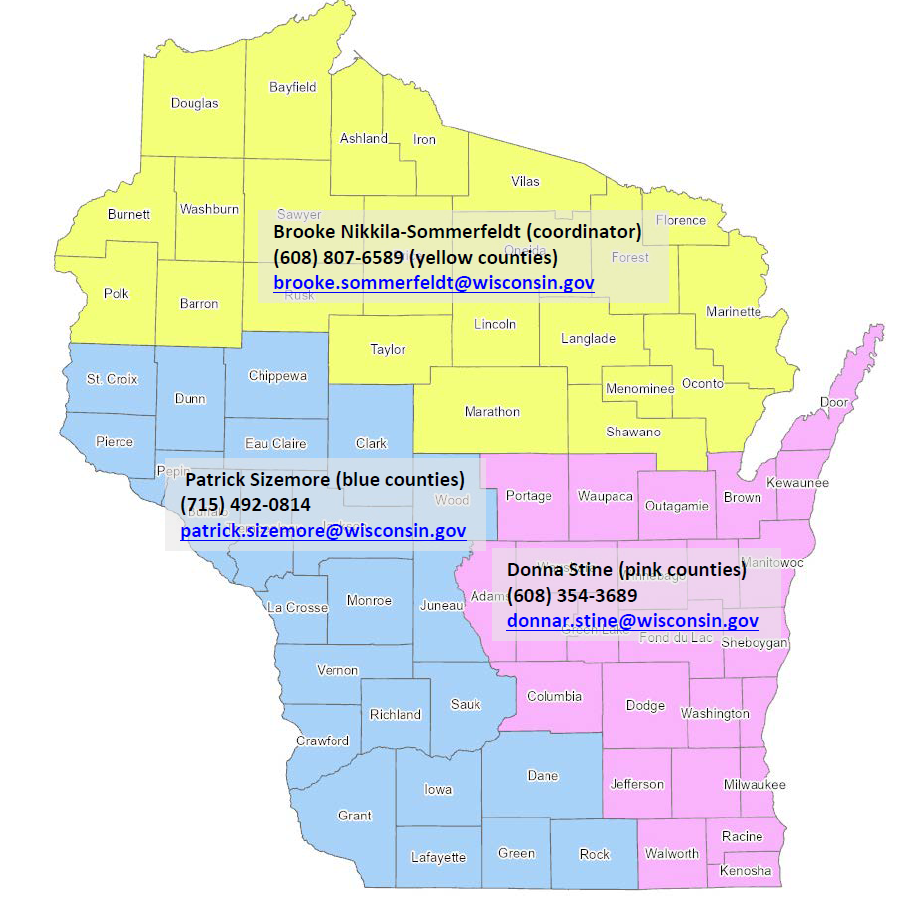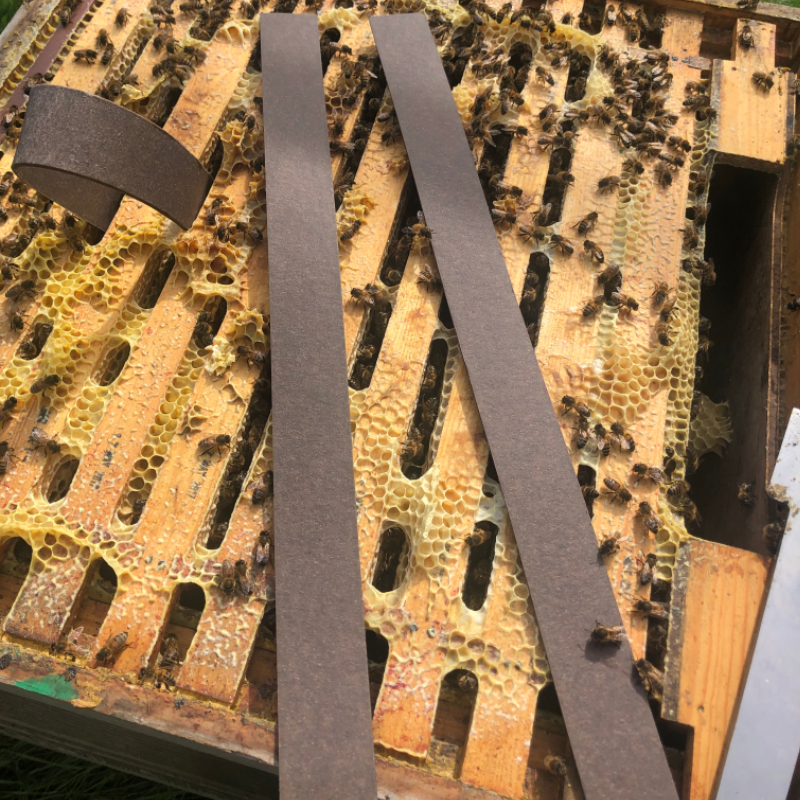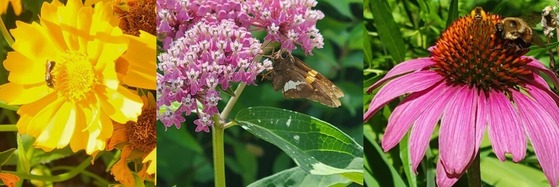
Did you know that the DATCP Apiary Program offers free, voluntary colony inspections to all Wisconsin beekeepers from approximately May through October? An inspection can help determine pest and disease issues, perform a varroa mite test, provide management advice, and more. Please note that inspection dates/times are scheduled on a first-come, first-served basis.
To schedule an apiary inspection, consult the apiary inspector territory map above and contact the apiary inspector of the county where your honey bee colonies are located. The apiary inspector will work with you to schedule a time to visit your apiary. You can also email DATCPapiary@wisconsin.gov or call the State Apiarist at (608) 807-6589 and they will connect you with an apiary inspector. Beekeepers should be present at the inspection to discuss hive history and to assist with lifting hive bodies. If you have more than one colony, a percentage of colonies within the apiary will be inspected for varroa mites, virus and disease symptoms, and exotic pests.
Are you a beekeeper with eight or more colonies and interested in expanding the dataset for honey bee health surveillance? Consider participating in the National Honey Bee Survey (NHBS). Wisconsin's apiary program has been voluntarily participating in the NHBS since 2011. This survey, which yields important scientific baseline data, is sponsored by the United States Department of Agriculture (USDA) Animal and Plant Health Inspection Service (APHIS) in collaboration with the USDA Agricultural Research Service (ARS). It is primarily geared at establishing the absence of Apis cerana and the parasitic mite Tropilaelaps in the US in order to safeguard crop pollination. Participating beekeepers volunteer to have their apiary inspected and to have samples collected and processed by the University of Maryland. Participants later receive diagnostic data related to those samples. Contact DATCPapiary@wisconsin.gov to see if we can include your apiary in the NHBS.
If you're a migratory beekeeper in need of a Certificate of Apiary Inspection required to move your honey bees from Wisconsin to another state (e.g., for crop pollination), you should contact us at DATCPapiary@wisconsin.gov to request an inspection with us a few weeks before you leave the state. After the inspection, the State Apiarist will provide you with an invoice (if applicable) and issue your Certificate(s) of Apiary Inspection once all fees are paid and data are evaluated. A DATCP apiary inspection is free, but each apiary certificate costs $50. Most states require certification to import honey bee colonies. If you are moving honey bees or regulated honey bee materials (e.g., beekeeping byproducts or beekeeping equipment) into another state, verify the destination state's requirements with their local apiary inspection service. For migratory inspections, colonies must be accessible in the yard and not yet loaded on the truck.
 Varroxsan Photo by Vita Bee
In June 2024, colleagues from DATCP's Agrichemical Management Bureau informed apiary program staff about a newly registered varroa control product. Earlier this spring, Varroxan, a new extended-release oxalic acid product, received approval with Environmental Protection Agency. DATCP received an application for the product to be registered in Wisconsin, and that registration was recently approved. While retailers may not have this product available until later this summer, this registered product can now be legally sold and used according to label directions in Wisconsin. According to product manufacturers, the product is comprised of fiberboard (cardboard) strips that are hung over the hives. The strips are placed inside the hive for 42-56 days, which would cover three open brood cycles, and be removed after 56 days. It can be used any time of the year and also during honey production when honey supers are present on the hive.
While DATCP does not endorse or have firsthand experience with this particular product, we are pleased to learn about expanded tools against varroa mites, which are the most serious challenge beekeepers currently face in managing for healthy honey bee colonies. For more information about honey bee pest management, visit the links below.
 From left to right, Coreopsis, Swamp Milkweed, and Purple Coneflowers are Perennials that Support Bees and Other Pollinators
The number of people interested in protecting pollinators is on the rise, as are "No Mow May" initiatives. While mowing less early and often can certainly be helpful to allow early flowering plants to support bees coming out of hibernation, people don't necessarily need to take the catchphrase quite so literally.
The basic idea of increasing the availability of flowers for pollinators is good. However, it is not crucial to postpone mowing for the entire month. For example, if you give dandelions a chance to flower but mow them in May before they go to seed, you can provide resources for pollinators while preventing their seed from spreading. For white clover, you may need to mow in May to encourage them to flower again if the flowers are going to seed.
Ground-nesting native bees, like the endangered rusty-patched bumble bee or miner bees, are also not likely harmed by mowing in May as they tend to prefer habitat other than lawns (NOTE: avoiding applications of systemic pesticides to soil can be an important way to protect these pollinators). Even if a rusty-patched queen does happen to dig a hole to overwinter in someone's lawn, they would be deeper, or about two inches underground where they would be unlikely to be impacted by mowing. Finally, replacing part of your lawn with native perennial flower beds can be a way to reduce the amount of mowing all season long, yielding more lasting benefits to pollinators than "No Mow May".
Hence, while “No Mow May” is a catchy slogan, we agree with the Minnesota Bee Squad's proposal to replace it with “Slow Mow Summer,” because mowing less, rather than not at all, can actually provide more benefits to bees and other pollinators. “Slow Mow Summer” takes the sentiment of “No Mow May” and expands it to the entire growing season since bees need pollen and nectar after May, too. In fact, many bee species emerge from hibernation in June or July, when planting native roses, coreopsis (tickseed), monarda (bee balm), milkweed, and pale purple coneflowers can provide crucial sustenance. Later in fall, aster, goldenrod, and cardinal flower can support bees and migrating monarchs.
There are many native plants to choose from if you want to support pollinators. Read Wisconsin Pollinator Protection Plan's Best Management Practices for Gardeners for more information!
Flowering plants pollianted by insect pollinators support countless other species in our ecosystem. Photo from University of Minnesota Bee Lab
Did you know there are 20,000 species of bees in the world with approximately 4,000 living in the United States and 400 species of native bees here in Wisconsin? These bees vary in color, shape, size, life cycles, and even their ability to sting. About 98% of our bee species are solitary, which means that they live all alone with the single female provisioning the nest, laying and caring for her brood, and foraging. Often having their nests in small holes in the ground or varying sized plant stems, these native bees are easy to overlook and go unnoticed by most. Our social bees and wasps, however, are not as easy to ignore, with their nests ranging from 50 individuals (some bumble bee species) to over 60,000 individuals in our honey bee colonies during the middle of summer!
Eighty percent of the world's flowering plants are pollinated by animals that include bees, wasps, flies, moths, beetles, hummingbirds, and even bats in some parts of the country. Wasps, flies, and moths can often be mistaken for bees, understandably. But not by you! By the end of this article, you're going to be able to see the differences and help save our beneficial pollinators.
Tips on Telling the Difference Between Similar(ish) Yellow and Black Insect Groups:
1. Yellowjacket wasps and honey bees. Evolution caused these two cousin species to diverge based on their diets, with one being a "plant eater" and the other being a "meat eater". Can you guess which is which? Yellowjacket wasps are the meat eaters, as they are important predators of our garden pests and perennial pollinators. Both are pollinators and social insects, meaning they live in a colony with one queen, female workers, and non-stinging male drones. Yellowjacket wasps nest in the ground or open-faced paper nests than begin formation in early spring before you even know they are there. Their nests often go unnoticed until August when the colony starts producing males and new queens for the next season. This means the whole nest dies by the second hard frost and do not continue to use that nest the following season.
Honey bees, although not native to Wisconsin, are highly beneficial pollinators whose colonies can successfully overwinter and live many years, if properly managed.
2. The Cicada killer wasp and northern giant hornet. Both can appear to be scary, but the cicada killer wasp is actually a zero on the scary scale. Here is why: she is a solitary wasp living in her ground nest using her stinger to paralyze and feed cicadas to her larvae. This perennial wasp is friendly and rarely stings anything other than cicadas.
The northern giant hornet may seem like a 10 on the scary scale, however, but that is not for us to worry about! They are currently not in Wisconsin or the United States, although populations were recently eradicated from Washington state. These hornets have been unfairly named the "murder hornet" since they kill honey bees (sometimes a whole colony) in Asia. As with varroa, the Asian honey bee (Apis cerana) has learned to live with this pest and will collectively ball up on the individual hornet and heat their bodies to a whopping 122 degrees F, causing both the bees and the hornet to die.
3. Bald-faced hornet and yellow-legged hornet. All hornets are wasps, but not all wasps are hornets, and this is definitely true for bald-faced hornets. Bald-faced hornets are actually "aerial yellowjackets" and in true yellowjacket fashion, they build their grey papery nests in bushes and trees and bravely defend it. They are also great predators of garden pests and help keep other insects at bay while pollinating flowers in their search for nectar.
The yellow-legged hornet, if established in the United States, could threaten populations of domestic honey bees and native bees as well as disrupt crop pollination. These hornets are slightly bigger than bald-faced hornet workers and are mostly black or dark brown in color with some orange or yellow and lack the classic white color of the bald-faced hornets. Populations of yellow-legged hornets detected in Georgia in 2023 are currently being eradicated by state officials. Yellow-legged hornets have never been detected in Wisconsin.
Invasive pests like the Northern Giant Hornet and Yellow-Legged Hornet shown in red above are sometimes mistaken by the public for native Bald-Faced Hornet or Giant Cicada Killer Wasp below
Now that you know some of the differences between similar-looking invasive and native insects, we hope you will tell those prone to killing every "scary" yellow and black insect that it could be a beneficial native pollinator. Here are some additional tips:
- Take a deep breath and observe the insect's behavior. If it’s on a flower, it’s at the grocery store.
- Are you near its nest? Will you be able to live respectfully with each other until the second hard frost when the colony or individual will naturally die off? Remember: annual pollinators like hornets, wasps, and native bees don’t repopulate their nests from the previous season!
- Take a few clear photos (yes, it’s hard to take a clear photo of a flying insect) or short video and send it to us at datcpapiary@wisconsin.gov and we can help you identify it.
- If after all that, you are STILL convinced you have detected Northern Giant Hornet, Yellow-Legged Hornet, or another invasive species not known to be present in Wisconsin, please take a picture and report it on our Pest Hotline at datcppesthotline@wi.gov or (866) 440-7523.
Learn more about Northern Giant Hornet (formerly known as the Asian Giant Hornet) and the Yellow-Legged Hornet at the links below:
6 Things to Know About The Asian Giant Hornet - Insect Diagnostic Lab
Asian Giant Hornets?—Nope! - Insect Diagnostic Lab
Yellow-Legged Hornet | Animal and Plant Health Inspection Service
Find more information about the DATCP Apiary Program and the Wisconsin Pollinator Protection Plan via the DATCP Beekeeping and Pollinators webpage.
Division of Agricultural Resource Management | Bureau of Plant Industry
Having trouble viewing this email? View it as a Web page.
|